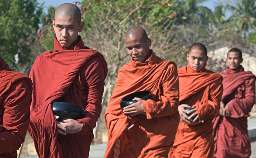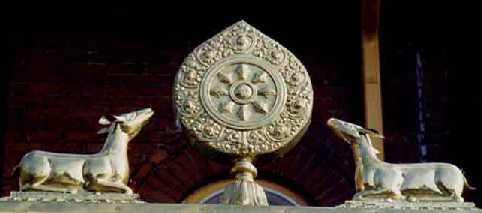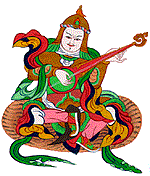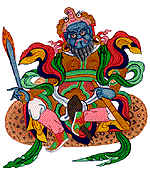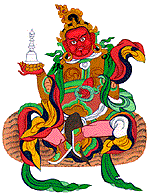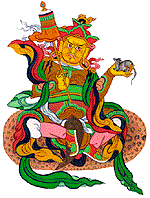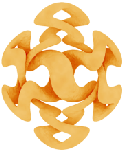
GENERAL BUDDHIST SYMBOLS BRIEF HISTORY OF SYMBOLISM IN BUDDHISMMany Buddhist symbols need to be considered within the culture of the people who follow it. Therefore, many of the early symbols relate to ancient India and can be found in Hinduism as well, although possibly with a somewhat different meaning. The historical Buddha lived around the sixth century BCE, but no Buddhist artifacts are known from before the third century BCE. In the scriptures, it is mentioned that the Buddha did occasionally use images like the 'Wheel of Life' to illustrate the teachings. The first archaeological evidence, mainly of ornamental stone carvings, comes from the time of the Emperor Asoka (273 - 232 BCE), who converted to Buddhism and made it a popular religion in India and beyond . In the second century BCE, people started to excavate Buddhist monasteries in rock, creating a large amount of artwork to withstand the ages. Probably the earliest typical Buddhist monument is the stupa, which was often specially decorated. The first actual Buddha images appeared around the first century BCE, so until then the artwork was largely symbolic in nature. With the appearance of Buddhist Tantra around the 6th century, a wealth of new artwork and symbolism appeared, as imagination and visualization form a major technique in meditation practices. From this moment on, a pantheon of deities and protectors appeared, together with a vast collection of symbolic items, such as the vajra and bell, mandalas etc.; see the page on Tantric Symbols. This tradition was mainly preserved in so-called 'Tibetan Buddhism', and partially in the Japanese Shingon tradition. SYMBOLS FOR THE BUDDHA
It is said that the Buddha was reluctant to accept images of himself, as he did not like to be venerated as a person. To symbolise the Buddha in the very early art, one used mainly the Eight Spoked Wheel and the Bodhi Tree, but also the Buddha's Footprints, an Empty Throne, a Begging Bowl and a Lion are used to represent him. The Eight-Spoked Dharma Wheel or 'Dharmachakra' (Sanskrit) symbolises the Buddha's turning the Wheel of Truth or Law (dharma = truth/law, chakra = wheel). The wheel (on the left and right) refers to the story that shortly after the Buddha achieved enlightenment, Brahma came down from heaven and requested the Buddha to teach by offering him a Dharmachakra. The Buddha is known as the Wheel-Turner: he who sets a new cycle of teachings in motion and in consequence changes the course of destiny. The Dharmachakra has eight spokes, symbolising
the Eight-fold Noble Path. The 3
swirling segments in centre represent the Buddha,
Dharma (the teachings) and Sangha
(the spiritual community).
From a beautiful online book from the Stupa Page: "After
wandering the countryside for about six years the Buddha finally
came to rest in a forest beside the Naranjara River, not far from
modern day Bodhgaya. Sitting under a Bodhi tree, ardently practicing
meditation, he finally realised his true nature. The next seven
days were spent under the tree experiencing the bliss of freedom
and contemplating the extent of his new understanding. The story
then goes on to relate The Throne is both a reference to Siddharta Gautama's royal ancestry and to the idea of spiritual kingship - enlightenment as ruler of the spiritual world. The ancient stone carvings above show the Dharmachakra and the Bodhitree on top of the throne. Sometimes the base of the throne is decorated with other symbols such as lions and deer, both associated with the Buddha's teachings.
The Begging-bowl refers to the
the story that shortly before the Buddha reached enlightenment,
a young woman named Sujata offered him a bowl of milk-rice. At that
moment, he was practicing austerity by eating extremely little.
But he realised at that moment that he would need to have more strength
for the final steps to enlightenment, and further fasting would
only reduce his energy. After he reached enlightenment, he is said
to have thrown away what little was left in the bowl to signify
his renunciation of all material possessions. Finding the middle
way between extreme austerity and complete attachment to life is
an important principle of Buddhism. What seems a much later development is the depiction of the Buddha's eyes (especially on stupas), as is frequently seen in Nepal. They look in all four directions, representing the omniscient mind of a Buddha. At exoticindiaart.com you can find a very interesting history of the development of the Buddha-image in art. THE THREE PRECIOUS JEWELS or TRIPLE GEM The
core of Buddhism is made up of the three pillars of the Buddha,
the Dharma (his teachings) and the Sangha (monks and nuns). Simply
explained, one could say that without the historical Buddha Shakyamuni
there would have been no Buddhist Dharma, nor Sangha. Without his
teachings, the Buddha would not have made much of a difference,
and also the spiritual community would not have existed. Without
the Sangha, the tradition would never have have been transmitted
through the ages. The Buddha would have been 'just' a historical
figure and his teachings would have been 'just' books. The
core of Buddhism is made up of the three pillars of the Buddha,
the Dharma (his teachings) and the Sangha (monks and nuns). Simply
explained, one could say that without the historical Buddha Shakyamuni
there would have been no Buddhist Dharma, nor Sangha. Without his
teachings, the Buddha would not have made much of a difference,
and also the spiritual community would not have existed. Without
the Sangha, the tradition would never have have been transmitted
through the ages. The Buddha would have been 'just' a historical
figure and his teachings would have been 'just' books. Obviously, the Triple Gem is usually represented as three jewels... DEERDeer are a direct reference to the Buddha's first teaching in the Deer Park, Sarnath, also called Dharmachakra Parivartan. The suggestion is that so wondrous was the Buddha's appearance and peaceful his presence that even the animals came to listen. In the Tibetan tradition, a monastery which holds the Kangyur and Tengyur collections of texts would have this symbol of deer on both sides of the Dharma-wheel on the roof.
|
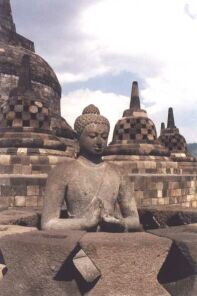 |
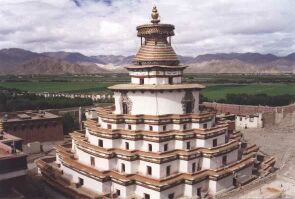 |
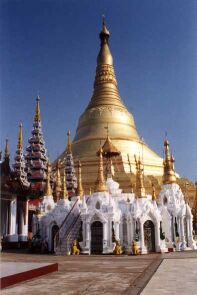 |
OFFERINGS
Making offerings is a very common practice in the East. Every offering has a specific meaning, for example offering light is to dispel the darkness of one's ignorance, or offering incense to increase one's ethical behaviour. Offering is considered a good training against greed and attachment.
In Tibet, many or all of the offerings are often replaced by little bowls filled with water which symbolises the offering of water for drinking and foot-washing, flowers, incense, light, perfume and food. This relates to the ancient tradition of how a very important guest should be received.
The Eight Offerings:
Offering water to cleanse the mouth or face:
It signifies auspiciousness or all the positive causes and conditions
which bring positive effects. So, make an offering of water which
is clean, fresh, cool, smooth, light, delicious, comfortable to
the throat and stomach - these qualities are the qualities of
auspiciousness.
Offering water to wash the feet: This is clear water mixed
with incense or sandalwood which is made as an offering to all
enlightened beings' feet. The symbolic meaning is purification.
By cleansing the feet of the enlightened beings, we cleanse all
our own negative karma and obscurations. By making offerings to
clean the enlightened beings feet, we are really cleaning the
"feet" of our own mind.
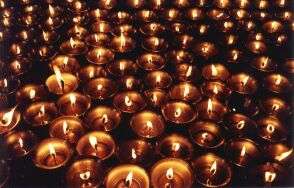 Offering flowers signifies the practice of generosity and
opens the heart.
Offering flowers signifies the practice of generosity and
opens the heart.
Offering incense symbolises moral ethics or discipline.
Offering light signifies the stability and clarity of patience,
the beauty which dispels all ignorance.
According to Ven. Norlha
Rinpoche: "It is also excellent to offer the butterlamps,
candles or light because this act of offering this light symbolizes
burning away our mental afflictions of desire, aggression, greed,
jealousy, pride and so forth. The other part of the symbolism
is that it is a way to burn away our illness."
"Offering butter lamps is the most powerful offering because their light symbolizes wisdom. Just as a lamp dispels darkness, offering light from a butter lamp represents removing the darkness of ignorance in order to attain Buddha’s luminous clear wisdom. The lamp offering is a sense offering to the Buddha’s eyes. Because Buddha’s eyes are wisdom eyes, they do not have the extremes of clarity or non-clarity. Our ordinary eyes, however, are obscured by the darkness of the two defilements –gross afflictive emotional defilements and subtle habitual defilements. While the Buddha does not have desire for offerings, we make offerings for the purpose of our own accumulation of merit & wisdom. Through the power of this accumulation, we can remove the cataracts of our ignorance eyes in order to gain Buddha’s supreme luminous wisdom eyes. When we offer light, the results are the realization of Clear Light wisdom phenomena in this life; the clarification of dualistic mind and the dispersal of confusion and realization of Clear Light in the bardo; and the increase of wisdom in each lifetime until one has reached enlightenment.
Traditionally, butter lamps are also offered as a dedication to the dead in order to guide them through the bardo by wisdom light. We can pray as well that this light guide all beings of the six realms, removing their obscurations so that they may awaken to their true wisdom nature.
With genuine faith & devotion, visualize that with your offerings, countless offering goddesses offer immeasurable light to all enlightened beings. You may recite the ‘Butter Lamp Offering Prayer’ from the Collection of Offering Prayers.”
Lama Tharchin Rinpoche
Offering of perfume or the fragrance from saffron or sandalwood.
It signifies perseverance or joyous effort. Through that one quality,
one develops all the qualities of enlightenment.
Offering of food which has a lot of different tastes signifies
samadhi, which is a nectar or ambrosia to feed the mind.
Offering of musical instruments. There are different types
of instruments -- cymbals, bells, guitars, lutes - - all of these
are offered. Their nature is wisdom, which makes an offering to
the ears of the Buddhas and Bodhisattvas and all the enlightened
beings. Sound represents wisdom because wisdom is a special power
of the mind which penetrates phenomena. Compassion is achieved
through great wisdom; interdependence of all phenomena is realised
through great wisdom. of course all phenomena have the nature
of interdependence, causes and conditions, but sound is especially
easy to understand.
The Eight Lucky Articles or Eight Bringers of Good Fortune to support the practitioner's efforts at reaching enlightenment. Each of these also represents an aspect of the 8-fold Noble Path:
The Mirror represents the Dharmakaya or Truth Body of the Buddha, having the aspects of purity (a mirror is clear of pollution) and wisdom (a mirror reflects all phenomena without distinction). Represents Right Thought.
Curd - just as this highly valued, pure white food is the result of a long process, so the clear nature of mind is revealed with practice over time as the defilements are dissolved. Represents Right Livelihood (no animal is harmed in its production).
Durva Grass is very resilient and is a symbol of long life. This is considered beneficial because one needs time to practice and attain enlightenment. Represents Right Effort.
The Wood Apple or Bilva Fruit is offered to remind the practitioner of the emptiness and conditioned nature of all phenomena in terms of dependent origination. Why the Bilva fruit was chosen to represent this is unknown. Represents Right Action - which bears the right fruit.
The Right-coiled Conch-shell represents the wish that the Buddhist teachings will be spread in all directions like the sounds emitted when the shell is used as a horn. Represents Right Speech.
Vermilion/Cinnabar are each red powders consisting of mercuric sulphide. In tantric Buddhist colour symbolism, red represents control. Thus, this offering is concerned with having control over one's capacities which are to be put to the effort of gaining enlightenment. Represents Right Concentration.
White Mustard Seeds This relates to the Buddha's response to a woman who came to him distraught at the loss of her child. He instructed her to collect a mustard seed (as common as salt or pepper at the time) from every home that never had a bereavement. As she returned empty-handed, the Buddha showed her that she was not alone in her sorrow and that death is an inescapable part of life. Represent Right Understanding. Mustard seeds are also used in many rituals to expel demons. They therefore symbolise also wrathful means at overcoming obstacles.
Precious Medicine - ghi-wang, literally meaning "cow essence", is a soothing and strengthening medicine obtained from gallstones in cattle or elephants. The substance's ability to deal with physical suffering symbolises to include suffering as part of the practice of Dharma. It represents Right Mindfulness, which acts as an antidote to the disease of ignorance and the suffering that it causes.
The Five Qualities of Enjoyment are also used as offerings, as when they come into contact with our senses, they give rise to the negative consequences of attachment and craving:
The Mirror is a symbol for visual form.
The Lute symbolises sound.
The Incense Burner represents smell.
The Fruit refers to for taste.
The Silk relates to touch.
In offering these qualities, one meditates on their nature and the intention of abandoning craving.
THE SEVEN JEWELS OF ROYAL POWER
The Seven Jewels of Royal Power are the accessories of the universal monarch (Skt. chakravartin). They represent different abilities or aids that a king must possess in order to stay in power and can be symbolically offered to the Buddha. These seven objects collectively symbolize secular power. They give the ruler knowledge, resources and power.
In the Buddhist interpretation a comparison is
drawn between the outward rule of the secular king and the spiritual
power of a practitioner. To the spiritual practitioner the Seven
Jewels represent boundless wisdom, inexhaustible spiritual resources
and invincible power over all inner and outer obstacles.
These seven jewels can also be found in the long mandala
offering ritual.
The Precious Queen - who represents the feminine pole, where the chakravartin is the masculine aspect. Those working to abandon negative mental states regard her as mother or sister. Her beauty and love for her husband are representative of the radiating, piercing joy of the Buddha's enlightenment.
The Precious General symbolises the wrathful power to overcome enemies.
The Precious Horse is able to travel among the clouds and mirror the Buddha's abandonment of, or "rising above", the cares of worldly existence.
The Precious Jewel which is sometimes depicted on the back of the precious horse, deals with the themes of wealth and unfolding (power and possibility). The jewel is said to aid the Chakravartin (Wheel-turning or Buddhist King) in his ability to see all things like a crystal ball. In the same way, a Buddha can perceive all things; recognising the manifold connections between all events, the relentless chain of cause and effect, and the nature of compounded existence. The Jewel can also symbolise a Wish-granting Jewel, a mythical gem which fulfills all wishes.
The Precious Minister or Householder represent two different aspects of the rule of the chakravartin which are closely related. The minister aids the chakravartin in carrying out his commands expeditiously, while the householder provides the very basic support. The wisdom of the Buddha, like the minister, is always present to him who has realised it, allowing him to cut through the bonds of ignorance. While the householder represents the support of the lay community, without which the monastic community could not continue.
The Precious Elephant is a symbol of the strength of the mind in Buddhism. Exhibiting noble gentleness, the precious elephant serves as a symbol of the calm majesty possessed by one who is on the path. Specifically, it embodies the boundless powers of the Buddha which are miraculous aspiration, effort, intention, and analysis. The image at the right says it all: a stupa - symbolic of the mind of a Buddha with a basis of strong elephants.
The Precious Wheel, sometimes depicted on the back of the precious elephant, is the same as the Dharmachakra, or the Wheel of Truth above.
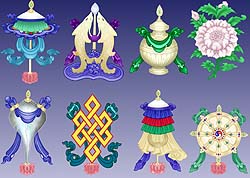 THE
EIGHT AUSPICIOUS SYMBOLS
THE
EIGHT AUSPICIOUS SYMBOLS
This set of symbols is very popular in Tibet, but is also known in Sanskrit as 'Ashtamangala', ashta means eight and mangala means auspicious.
The Umbrella or parasol (chhatra) embodies notions of wealth or royalty, for one had to be rich enough to possess such an item, and further, to have someone carry it. It points to the "royal ease" and power experienced in the Buddhist life of detachment. It also symbolises the wholesome activities to keep beings from harm (sun) like illness, harmful forces, obstacles and so forth, and the enjoyment of the results under its cool shade.
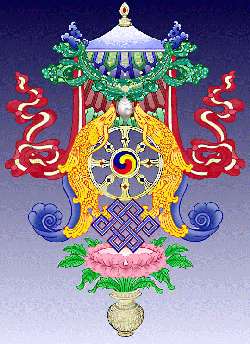 The
Golden Fish (matsya) were originally symbolic of the rivers
Ganges and Yamuna, but came to represent good fortune in general,
for Hindus, Jain and Buddhists. Within Buddhism it also symbolises
that living beings who practice the dharma need have no fear to
drown in the ocean of suffering, and can freely migrate (chose their
rebirth) like fish in the water.
The
Golden Fish (matsya) were originally symbolic of the rivers
Ganges and Yamuna, but came to represent good fortune in general,
for Hindus, Jain and Buddhists. Within Buddhism it also symbolises
that living beings who practice the dharma need have no fear to
drown in the ocean of suffering, and can freely migrate (chose their
rebirth) like fish in the water.
The Treasure Vase (bumpa) is a sign of the inexhaustible riches available in the Buddhist teachings, but also symbolises long life, wealth, prosperity and all the benefits of this world. (There is even a practice which involves burying or storing treasure vases at certain locations to generate wealth, eg. for monasteries or dharma centers.)
The Lotus (padma) is a very important
symbol in India and of Buddhism. In brief, it refers to the complete purification
of body, speech and mind, and the blossoming of wholesome deeds
in liberation. The lotus refers to many aspects of the path, as
it grows from the mud (samsara), up through muddy water it appears
clean on the surface (purification), and finally produces a beautiful
flower (enlightenment). The white blossom represents purity, the
stem stands for the practice of Buddhist teachings which raise the
mind above the (mud of) worldly existence, and gives rise to purity
of mind.
An open blossom signifies full enlightenment; a closed blossom signifies
the potential for enlightenment.
From the website Exotic India Art:
"The lotus does not grow in Tibet and so Tibetan art has only stylized versions of it. Nevertheless, it is one of Buddhism's best recognized motifs since every important deity is associated in some manner with the lotus, either being seated upon it or holding one in their hands.
The roots of a lotus are in the mud, the stem grows up through the water, and the heavily scented flower lies above the water, basking in the sunlight. This pattern of growth signifies the progress of the soul from the primeval mud of materialism, through the waters of experience, and into the bright sunshine of enlightenment. Though there are other water plants that bloom above the water, it is only the lotus which, owing to the strength of its stem, regularly rises eight to twelve inches above the surface.
Thus says the Lalitavistara, 'the spirit of the best of men is spotless, like the lotus in the muddy water which does not adhere to it.' According to another scholar, 'in esoteric Buddhism, the heart of the beings is like an unopened lotus: when the virtues of the Buddha develop therein, the lotus blossoms; that is why the Buddha sits on a lotus bloom.'Significantly, the color of the lotus too has an important bearing on the symbology associated with it:
1). White Lotus (Skt. pundarika; Tib. pad ma dkar po): This represents the state of spiritual perfection and total mental purity (bodhi). It is associated with the White Tara and proclaims her perfect nature, a quality which is reinforced by the color of her body.
2). Red Lotus (Skt. kamala; Tib: pad ma chu skyes): This signifies the original nature and purity of the heart (hrdya). It is the lotus of love, compassion, passion and all other qualities of the heart. It is the flower of Avalokiteshvara, the bodhisattva of compassion.
3). Blue Lotus (Skt. utpala; Tib. ut pa la): This is a symbol of the victory of the spirit over the senses, and signifies the wisdom of knowledge. Not surprisingly, it is the preferred flower of Manjushri, the bodhisattva of wisdom.
4). Pink Lotus (Skt. padma; Tib. pad ma dmar po): This the supreme lotus, generally reserved for the highest deity. Thus naturally it is associated with the Great Buddha himself."
Teoh Eng Soon, in his book The Lotus in the Buddhist Art of India, traces the first appearance of the lotus in Buddhist art to the columns built by Asoka in the 3rd Century BCE. However, the lotus is found frequently in the early Buddhist texts.
The lotus (padme) is an important symbol in Tibetan Buddhism and is commonly associated with the process of becoming a buddha. In Tibetan Buddhist iconography, buddhas are often seated on lotus thrones, indicating their transcendent state. A lotus is born in the muck and mud at the bottom of a swamp, but when it emerges on the surface of the water and opens its petals, a beautiful flower appears, unstained by the mud from which it arose. Similarly, the compassion and wisdom of buddhas arise from the muck of the ordinary world, which is characterized by fighting, hatred, distrust, anxiety, and other negative emotions. These emotions tend to cause people to become self-centered and lead to suffering and harmful actions. But just as the world is the locus of destructive emotions, it is also the place in which we can become buddhas, perfected beings who have awakened from the sleep of ignorance and who perceive reality as it is, with absolute clarity and with profound compassion for suffering living beings.
Just as the lotus arises from the bottom of a swamp, so buddhas were former humans, immersed in the negative thoughts and actions in which all ordinary beings engage: the strife, wars, petty jealousies, and hatreds to which all humans, animals, and other creatures are subject. Through their meditative training, however, buddhas have transcended such things, and like lotuses have risen above their murky origins and look down on them unsullied by the mud and mire below.
The symbolism may be extended still further, because buddhas do not simply escape the world and look down on others with pity or detached amusement; rather, like the lotus, which has roots that still connect it with the bottom of the swamp, buddhas continue to act in the world for the benefit of others, continually manifesting in various forms in order to help them, to make them aware if the reality of their situations, and to indicate the path to the awakening of buddhahood, which can free them from all suffering.
From Introduction to Tibetan Buddhism by John Powers
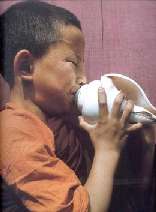 The
Conch (shankha), which is also used as a horn, symbolises
the deep, far reaching and melodious sound of the teachings, which
is suitable for all disciples at it awakens them from the slumber
of ignorance to accomplish all beings' welfare.
The
Conch (shankha), which is also used as a horn, symbolises
the deep, far reaching and melodious sound of the teachings, which
is suitable for all disciples at it awakens them from the slumber
of ignorance to accomplish all beings' welfare.
The Auspicious or Endless Knot (shrivatsa) is a geometric diagram which symbolises the nature of reality where everything is interrelated and only exists as part of a web of karma and its effect. Having no beginning or end, it also represents the infinite wisdom of the Buddha, and the union of compassion and wisdom. Also, it represents the illusory character of time, and long life as it is endless.
The Victory Banner (dhvaja) symbolises the victory of the Buddha's teachings over death, ignorance, disharmony and all the negativities of this world, and victory over. The roofs of Tibetan monasteries are often decorated with victory banners of different shapes and sizes.
The Dharma-Wheel (Dharmachakra); it is said that after Siddharta Gautama achieved enlightenment, Brahma came to him, offered a Dharma-Wheel and requested the Buddha to teach. It represents the Buddhist teachings (see above).
You can find a good article on the eight auspicious symbols at exoticindiaart.com.
THE BUDDHIST FLAG
A
much more recent symbol is the Buddhist flag. It was in designed
in 1880 by Colonel Henry Steele Olcott an American journalist. It
was first hoisted in 1885 in Sri Lanka and is a symbol of faith
and peace, and is now used throughout the world to represent the
Buddhism.
The five colours of the flag represent the colours of the aura that
emanated from the body of the Buddha when he attained Enlightenment.
Loving kindness, peace and universal compassion The Middle Path - avoiding extremes, emptiness Blessings of practice - achievement, wisdom, virtue, fortune and dignity Purity of Dharma - it leads to liberation, outside of time or space The Buddha's Teaching - wisdom
THE SWASTIKA
The Swastika is a well-know good-luck symbol from India. Unfortunately, it is too well known in the west, as the Nazis chose it as their main symbol. In Sanskrit, swastika means "conducive to well-being". In the Buddhist tradition, the swastika symbolizes the feet or footprints of the Buddha and is often used to mark the beginning of texts. Modern Tibetan Buddhism uses it as a clothing decoration. With the spread of Buddhism, it has passed into the iconography of China and Japan where it has been used to denote plurality, abundance, prosperity and long life.
(In India, Hindus use the swastika to mark the opening pages of account books, thresholds, doors, and offerings, the right-hand swastika is a solar symbol and the left-hand version represents Kali and magic. Among the Jains it is the emblem of their seventh Tirthankara. Other uses of the symbol: in ancient Mesopotamia it was a favourite symbol on coinage, In Scandinavia it was the symbol for the god Thor's hammer. In early Christian art it was called the gammadion cross because it was made of four gammas. It is also found in Mayan and Navajo art.)
MOUNTAINS
From about.com:
"There are two key mountains in Buddhist symbolism. The first is Vulture Peak in northern India where the Buddha is said to have delivered a number of sermons. Vulture Peak has particular significance in Mahayana Buddhism as one of its key texts, the Lotus Sutra, is said to have developed out of the Buddha's teachings at Vulture Peak [also the very important Heart Sutra was taught here]. The second belongs to Buddhist cosmology and is known as Mount Meru, the mythological center of the Buddhist universe and the link between the hells below the earth and the heavens above."
In China, there are the so-called four sacred mountains (not to be confused with the Taoist five sacred mountains). They are:
- Pu Tuo Shan, Buddhist mountain of the east, Zhejiang province, 284 meters. Sacred to Bodhisattva Kuan-Yin.
- Wu Tai Shan, Buddhist mountain of the north, Shanxi province, 3061 meters. Sacred to Bodhisattva Manjushri.
- Emei Shan, Buddhist mountain of the west, Sichuan province, 3099 meters. Sacred to Bodhisattva Samantabhadra.
- Jiu Hua Shan, Buddhist mountain of the south, Anhui province, 1341 meters. Sacred to Bodhisattva Kshitigarbha.
See also this page from Sacred Sites.
In Tibet, the 6,600 meter high Mount Kailash is often identified as the mountain of the gods, and even Mount Meru (the axis of the universe) with its pyramid shape. See the page on Tibetan Symbols.
THE FOUR GUARDIAN KINGS (Skt: Lokapala)
This information comes from Ratna Henry Chia's World of Buddhism.
The Four Guardian Kings are the protectors of the four cardinal directions and are almost always found at the entrance to monasteries and temples. They each have two hands and are dressed in the ornate armour and clothing of a warrior king. They may be depicted either sitting or standing.
white in color and plays a lute.
blue in color and carries a sword and scabbard.
red in color and holds a small stupa in his right hand and a serpent in his left.Vaishravana, the King of the North
yellow in color and carries a banner of victory in his right hand and a mongoose that vomits jewels in his left.
LINKS
This page was translated in Italian ![]() , and is available at Cultorweb.com
, and is available at Cultorweb.com
Web teachings on Making
Light Offerings by Lama Zopa Rinpoche. A good collection
of Buddhist symbols is found at Buddha
Mind
A huge collection of links
on Buddhist Symbols
Tibetan Clipart in Vector
Graphics to illustrate anything: support this project to educate
Tibetan youngsters
An interesting collection of symbols and their explanation can be
found on the Khandro
website.
Also have a look at Ratna
Henry Chia's page.
A great collection of information
on Buddhist ceremonies in the Thai tradition.
Altar offerings
in the Tibetan tradition.
Making waterbowl
offerings by Lama Zopa Rinpoche
Making prostrations
Offerings katas
(silk scarves) in the Tibetan tradition.
The images of the 8 auspicious symbols are courtesy of Osel
Shen Phen Ling.
The
symbolism of Experience by Chogyam Trungpa Rinpoche
Making
incense offering
If you are looking for Chinese symbolism, check out Gotheborg.com
Last updated: May 11, 2015
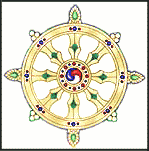
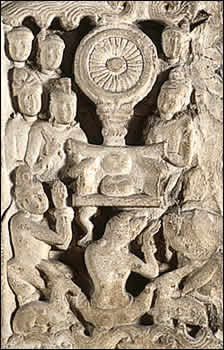
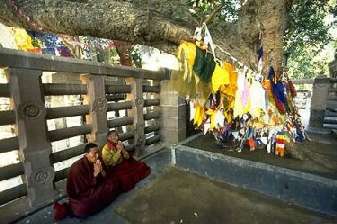 The
Bodhi Tree refers to the tree under which the Buddha achieved
enlightenment (See image on the right.).
The
Bodhi Tree refers to the tree under which the Buddha achieved
enlightenment (See image on the right.).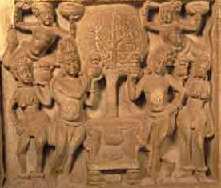 four other periods of seven days, each spent
under a different tree - the Banyan, the Mucalinda and the Rajayatana
tree and then once more back to the Banyan. Each of these 'tree
scenes' has its own well known story which space here does not allow.
The tree of enlightenment is called, in Latin, ficus religiosa,
or sacred tree. It is also known as the pipal tree. For Buddhists
it is generally called the Bodhi, or Bo tree. Bodhi is the Pali
and Sanskrit word for enlightenment. There is a descendant of the
original tree still growing at Bodhgaya and Bodhi trees are commonly
found in Buddhist centres all over the world."
four other periods of seven days, each spent
under a different tree - the Banyan, the Mucalinda and the Rajayatana
tree and then once more back to the Banyan. Each of these 'tree
scenes' has its own well known story which space here does not allow.
The tree of enlightenment is called, in Latin, ficus religiosa,
or sacred tree. It is also known as the pipal tree. For Buddhists
it is generally called the Bodhi, or Bo tree. Bodhi is the Pali
and Sanskrit word for enlightenment. There is a descendant of the
original tree still growing at Bodhgaya and Bodhi trees are commonly
found in Buddhist centres all over the world."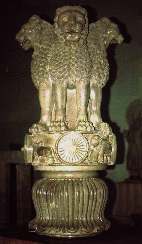 The
Lion is one of Buddhism's most potent symbols. Traditionally,
the lion is associated with regality, strength and power. It is
therefore an appropriate symbol for the Buddha who tradition has
it was a royal prince. The Buddha's teachings are sometimes referred
to as the 'Lion's Roar', again indicative of their strength and
power.
The
Lion is one of Buddhism's most potent symbols. Traditionally,
the lion is associated with regality, strength and power. It is
therefore an appropriate symbol for the Buddha who tradition has
it was a royal prince. The Buddha's teachings are sometimes referred
to as the 'Lion's Roar', again indicative of their strength and
power. 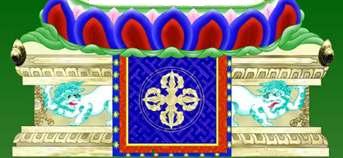 The
image on the left shows a capital from a pillar of Asoka: the Lions
of Sarnath. Sarnath is where the Buddha first preached, and these
lions echo his teachings to the four quarters of the world, sometimes
called 'the Lion's Roar'. The wheel symbolizes Buddhist law and
also Asoka's legitimacy as an enlightened ruler.
The
image on the left shows a capital from a pillar of Asoka: the Lions
of Sarnath. Sarnath is where the Buddha first preached, and these
lions echo his teachings to the four quarters of the world, sometimes
called 'the Lion's Roar'. The wheel symbolizes Buddhist law and
also Asoka's legitimacy as an enlightened ruler. 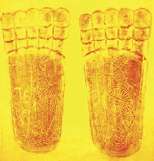 From
the
From
the 